
Walden's hornbill locally called dulungan, also known as the Visayan wrinkled hornbill, rufous-headed hornbill or writhe-billed hornbill, is a critically endangered species of hornbill living in the rainforests on the islands of Negros and Panay in the Philippines. It is closely related to the writhed hornbill, but can be recognized by the yellow throat and ocular skin in the male, and the blue throat and ocular skin in the female. Its binomial name commemorates the Scottish ornithologist Viscount Walden.

The Mindanao hornbill, sometimes called the Mindanao tarictic hornbill, is a medium-small species of hornbill found in the canopy of rainforests on Mindanao, Dinagat, Siargao and Basilan in the southern Philippines. As is the case with all Philippine tarictic hornbills, it has been considered a subspecies of P. panini. The Samar hornbill is often included as a subspecies of the Mindanao hornbill.
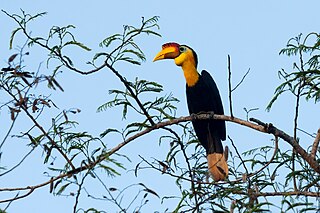
The wrinkled hornbill or Sunda wrinkled hornbill is a medium-large hornbill which is found in forest in the Thai-Malay Peninsula, Sumatra and Borneo.

The rhinoceros hornbill is a large species of forest hornbill (Bucerotidae). In captivity it can live for up to 35 years. It is found in lowland and montane, tropical and subtropical climates and in mountain rain forests up to 1,400 metres in Borneo, Sumatra, Java, the Malay Peninsula, Singapore, and southern Thailand.
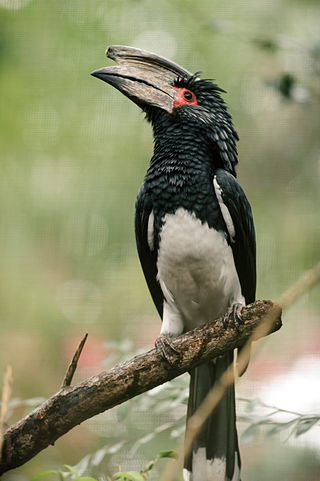
The trumpeter hornbill is a medium-sized hornbill, with length between 58 and 65 cm, characterized by a large grey casque on the bill, smaller in females. The eyes are brown or red, with pink surrounding skin. Body mass is between 0.45 and 1 kg. It is similar to silvery-cheeked hornbill. Distinguishing features include an all-black back, white belly and white underwing coverts, and red facial skin.

Tickell's brown hornbill, also known as the rusty-cheeked hornbill, is a species of hornbill found in forests in Burma and adjacent western Thailand. Austen's brown hornbill is sometimes considered as a subspecies of Tickell's brown hornbill.

Austen's brown hornbill is a species of hornbill found in forests from northeastern India and south to Vietnam and northern Thailand. It is sometimes included as a subspecies of Tickell's brown hornbill.

Bucerotiformes is an order of birds that contains the hornbills, ground hornbills, hoopoes and wood hoopoes. These birds were previously classified as members of Coraciiformes. The clade is distributed in Africa, Asia, Europe and Melanesia.

Sumba hornbill, or known natively as Julang is a large bird belonging to the family of Bucerotidae, endemic and native to the Indonesian island of Sumba. The scientific name commemorates British colonial administrator and zoological collector Alfred Hart Everett.
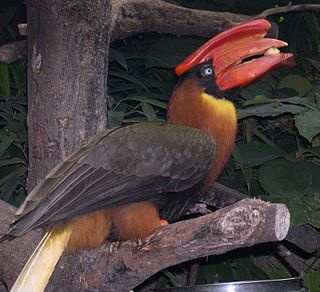
The rufous hornbill, also known as the Philippine hornbill and locally as kalaw, is a large species of hornbill endemic to the Philippines. They are referred by locals as the "clock-of-the-mountains" due to its large booming call which typically occur of every hour. It occurs in moist tropical lowland forest. They are now considered to be a threatened species and its reasons for decline being habitat destruction, hunting and poaching for the illegal pet trade.

The Sulawesi hornbill, also known as the Sulawesi tarictic hornbill, Temminck's hornbill or Sulawesi dwarf hornbill, is a relatively small, approximately 45 cm (18 in) long, black hornbill. The male has a yellow face and throat, and yellowish horn bill with black markings. The female has all-black plumage and a darker bill.

The Palawan hornbill is a large forest bird endemic to the Philippines. It is one of the 11 endemic hornbills in the country. It is only found in Palawan and nearby islands of Balabac, Busuanga, Calauit, Culion and Coron. It is locally known as 'talusi' in the language Cuyunon, It is threatened by habitat loss, hunting and trapping for the cage-bird trade.
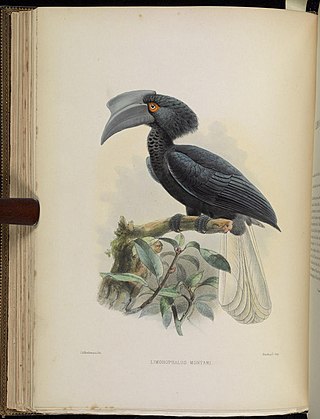
The Sulu hornbill, or Montano's hornbill, is a species of hornbill in the family Bucerotidae. It is endemic to the Sulu archipelago in the Philippines, with the remaining populations in Tawi-Tawi with it believed to be hunted to extinction on Jolo. Its natural habitat is tropical moist forests. It is threatened by habitat loss as well as potential harvesting for food. Its diet includes fruit, insects, and small lizards.

The Mindoro hornbill is a species of hornbill in the family Bucerotidae. It is endemic to forests on Mindoro in the Philippines found in tropical moist lowland forests. As is the case with all Philippine tarictic hornbills, it was once considered a subspecies of P. panini. It is the only tarictic hornbill where both sexes are creamy-white and black. The sexes are very similar, differing primarily in the colour of the ocular ring. It is threatened by habitat loss, and is consequently considered endangered by the IUCN.

The olive-capped flowerpecker is a species of bird in the family Dicaeidae. It is endemic to the island of Mindanao in the Philippines.Its natural habitat is tropical moist montane forest.

The whiskered flowerpecker is a species of bird in the family Dicaeidae. It is endemic to the island of Mindanao in the Philippines.
The Sulu boobook or Sulu hawk-owl is a species of owl in the family Strigidae. It is endemic to the Sulu Archipelago in the Philippines. It was previously known as a subspecies of the Philippine hawk-owl, but was reclassified in 2012, as voice and other evidence suggested it was a distinct species. It is found in tropical moist lowland forest. It is threatened by habitat loss.
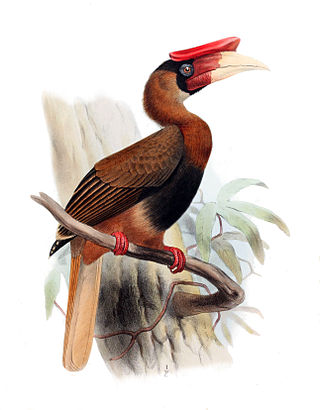
The Southern rufous hornbill, is a large species of hornbill endemic to the Philippines. It inhabits Mindanao, Dinagat, Siargao, Balut, Bucas, Talikud and Basilan islands of the Philippines. It prefers rainforest habitats and eats fruits, small animals, insects, and seeds. It is threatened by hunting, illegal pet trade, and use of biological resources in their habitat which all leads to their population declining.



















